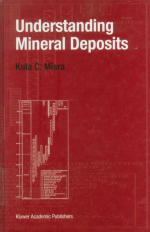Добрый день, Коллеги. Важное сообщение, просьба принять участие. Музей Ферсмана ищет помощь для реставрационных работ в помещении. Подробности по ссылке
Understanding mineral deposits / Понимание (изучение) месторождений полезных ископаемых
Mineral deposits have supplied useful or valuable material for human consumption long before they became objects of scientific curiosity or commercial exploitation. In fact, the earliest human interest in rocks was probably because of the easily accessible, useful (e.g., red pigment in the form of earthy hematite) or valuable (e.g., native gold and gemstones) materials they contained at places. In modern times, the study of mineral deposits has evolved into an applied science employing detailed field observations, sophisticated laboratory techniques for additional information, and computer modeling to build complex hypotheses. Understanding concepts that would someday help geologists to find new mineral deposits or exploit the known ones more efficiently have always been, and will continue to be, at the core of any course on mineral deposits, but it is a fascinating subject in its own right, even for students who do not intend to be professional economic geologists. I believe that a course on mineral deposits should be designed as a "capstone course" that illustrates a comprehensive application of concepts from many other disciplines in geology (mineralogy, stratigraphy and sedimentation, structure and tectonics, petrology, geochemistry, paleontology, geomorphology, etc.).
This book is intended as a text for such an introductory course in economic geology, primarily for senior undergraduate and graduate students in colleges and universities. It should also serve as a useful information resource for professional economic geologists. The overall objective of the book is to provide the reader with a critical understanding of selected classes mineral deposits: how are they distributed in space and geologic time, what are their distinguishing and general characteristics, and what can be inferred about their genesis from the available data. The expectation is that the information and discussions in this text will provide students with an insight into the formulation of appropriate exploration strategies for various classes of mineral deposits and kindle their interest in further research on aspects of mineral deposits that are poorly understood or that remain unresolved.
As an applied discipline, the study of economic geology requires a background in other disciplines of geology (particularly mineralogy, petrology, structural geology, and stratigraphy and sedimentation) as well as in allied sciences, such as physics and chemistry. It is assumed that the student has had one or more courses in these subjects and is in a position to appreciate the applications of various principles taught in those courses to issues related to mineral deposits. There is an emphasis on geochemistry throughout the book; this is necessary because the formation of almost all mineral deposits ultimately involves the chemical precipitation of minerals from fluids oi appropriate characteristics.
Considering the vast spectrum of mineral deposits that are either of potential economic interest or are actually being exploited for our use, it is practically impossible to include a comprehensive treatment of mineral deposits in an introductory text of this kind constrained by page limitations. The selection included here is basec on what I perceive as the more interesting (and usually controversial) classes ol deposits, especially from the points of view of origin and crustal evolution in space anc time. This does not imply that the classes of deposits excluded from consideration here are not interesting or that their origins are devoid of controversy, but I had to draw the line somewhere.
A recurring problem I have had to deal with in writing this book is to keep i updated with the latest information, which is being produced at an ever increasing rate In addition, space limitation has compelled me to a selection of the references I have used, a judgement, which I am afraid, is probably not totally devoid of personal bias.




